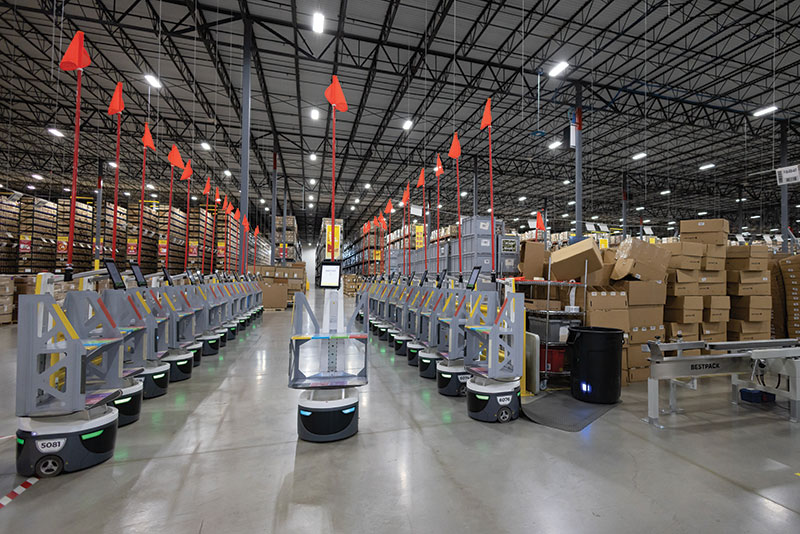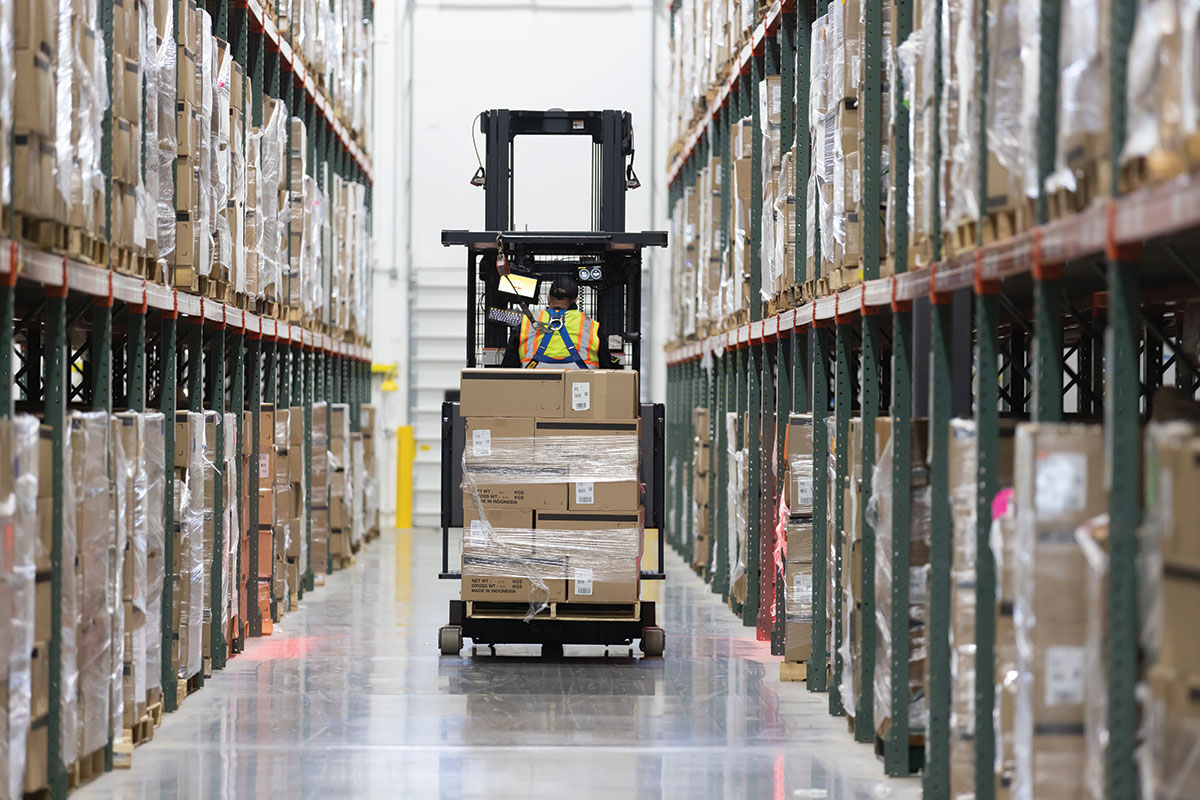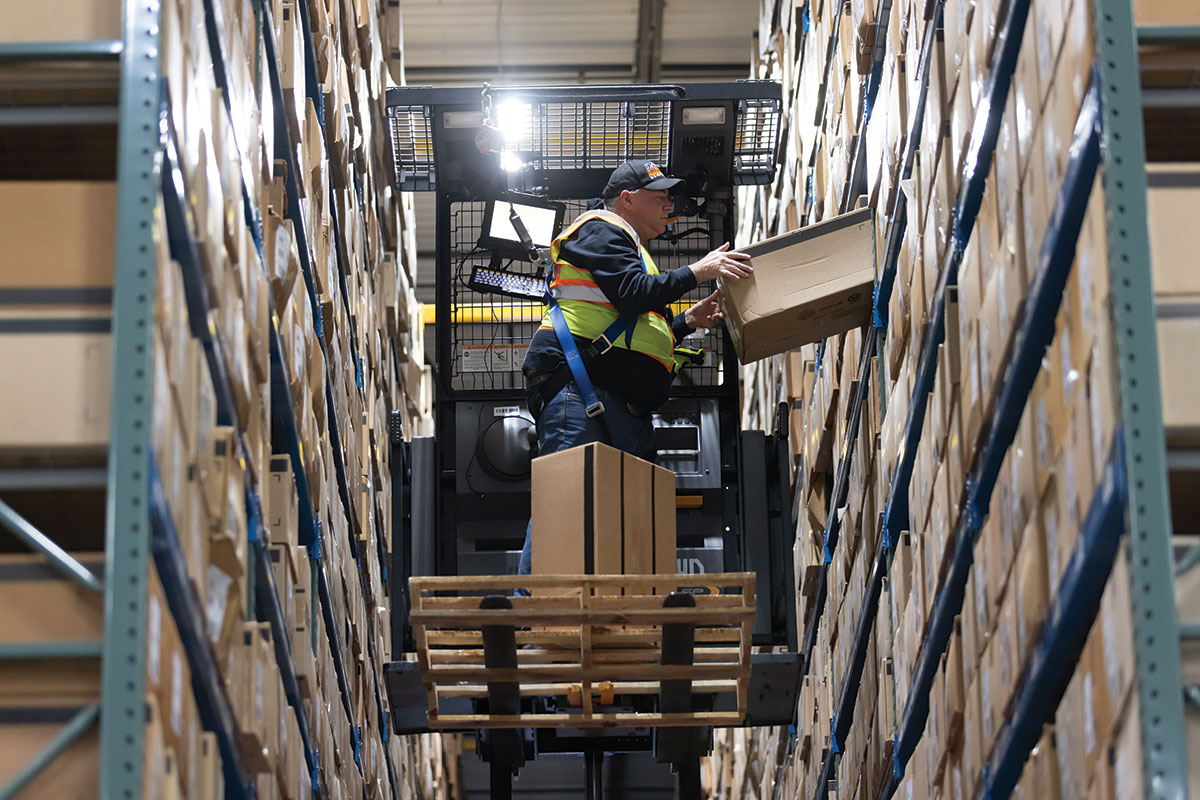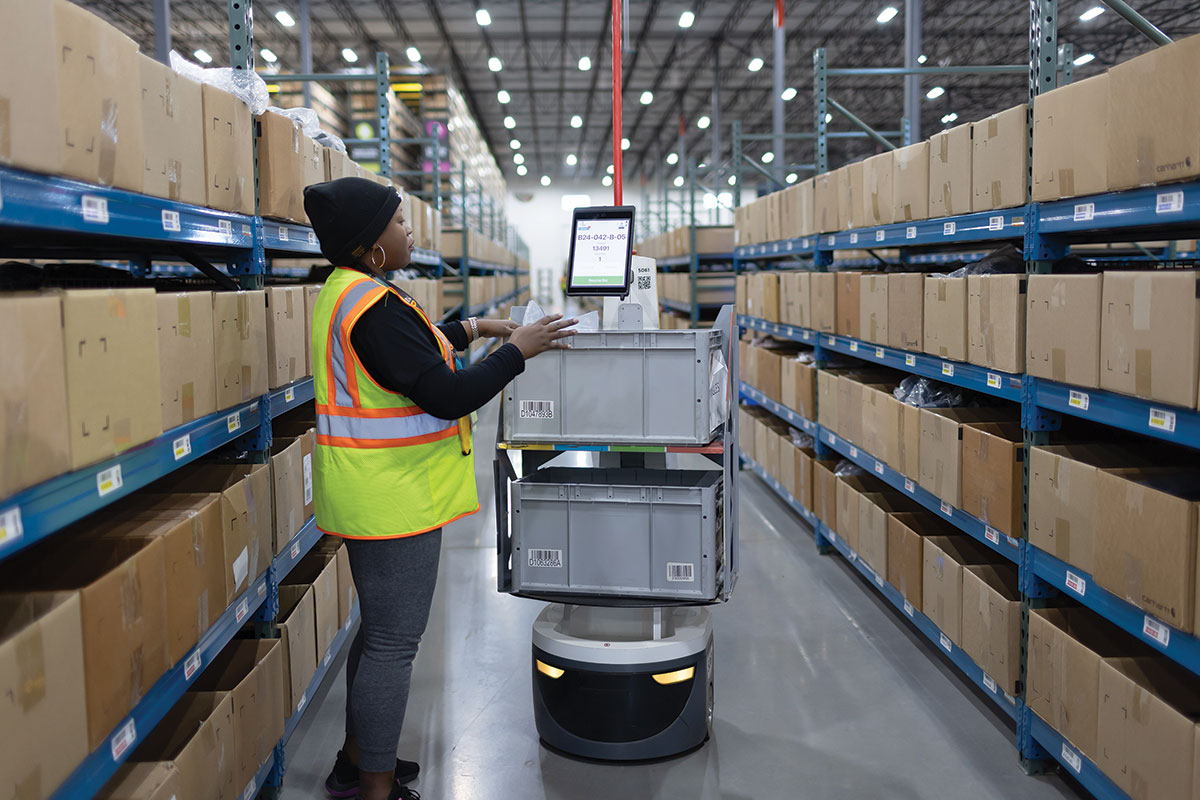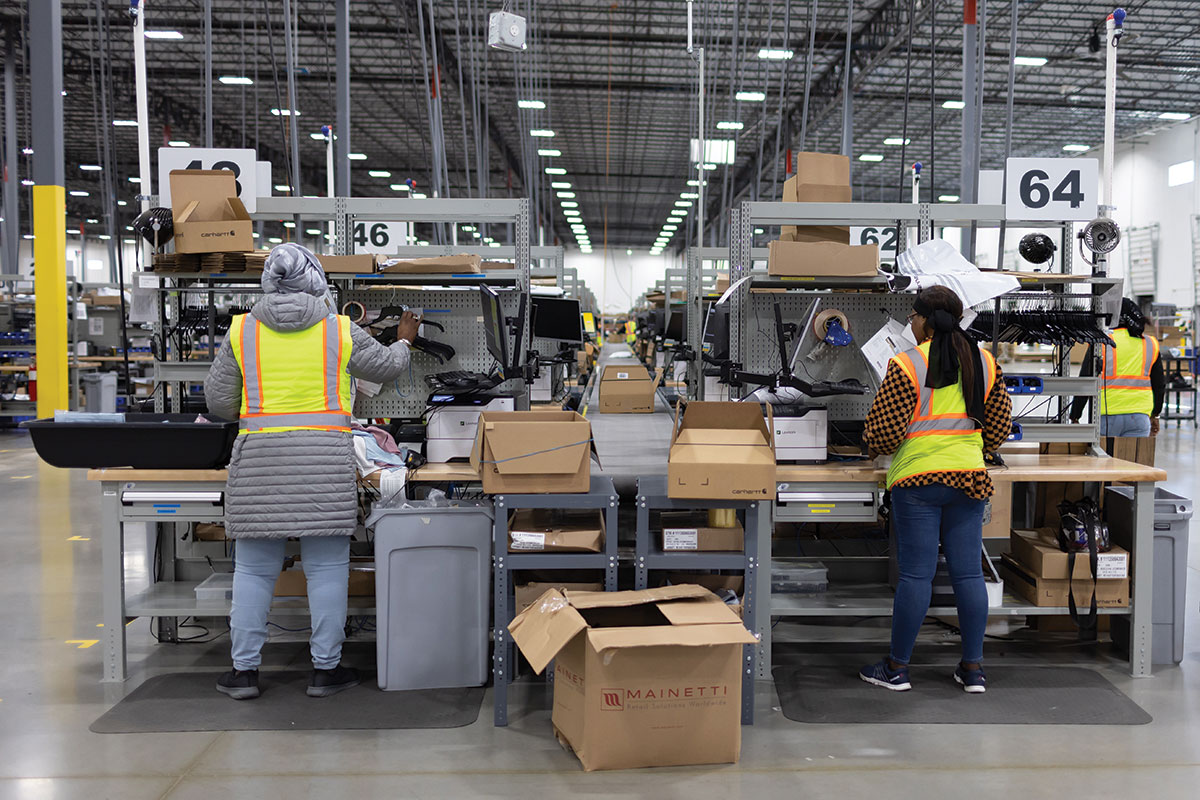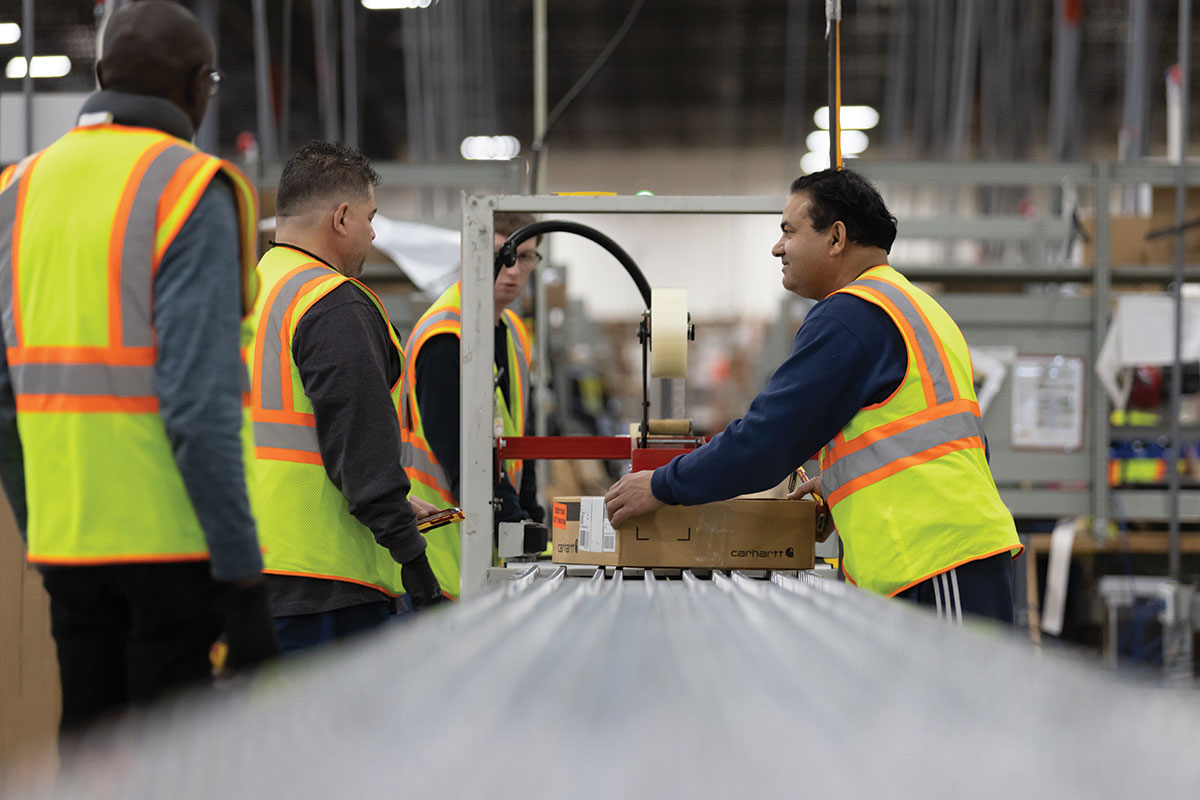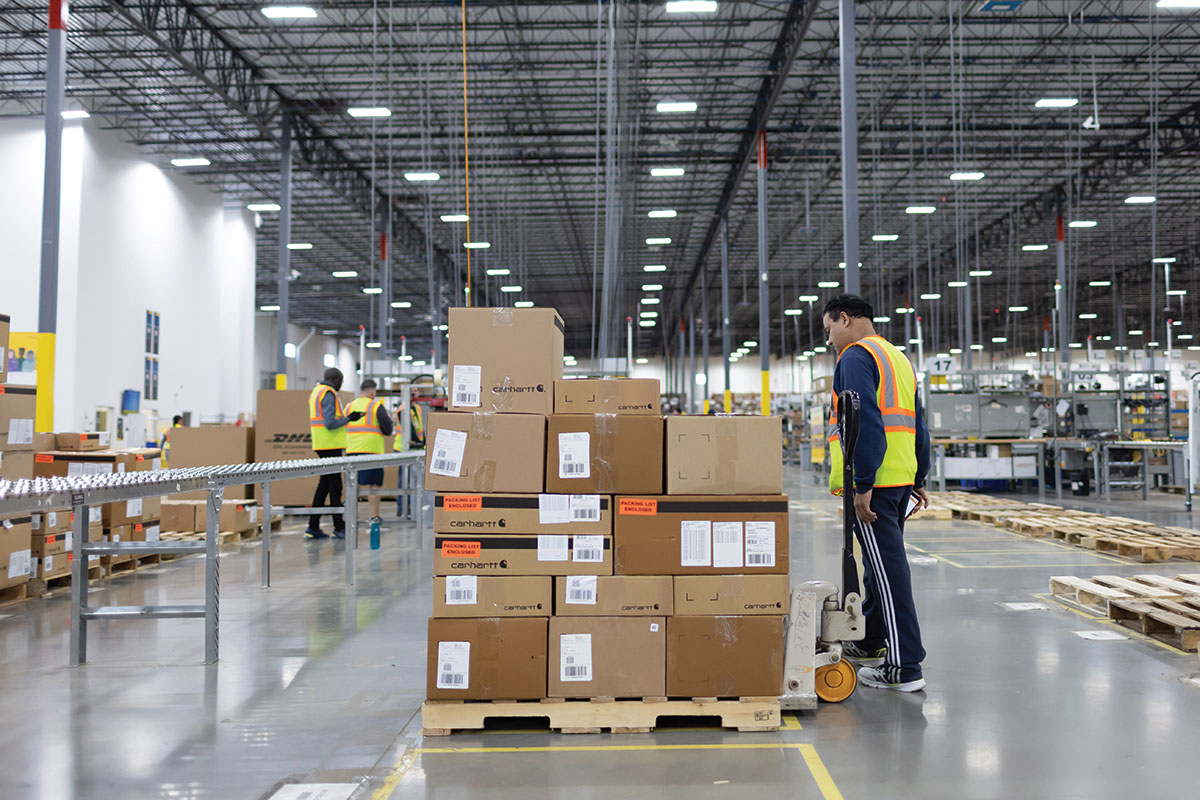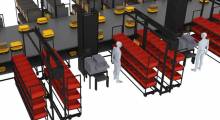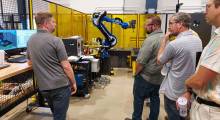During a time of supply chain volatility and disruptions, to say nothing of economic uncertainty, Carhartt is contending with a different kind of challenge: The business just keeps growing. And, it’s not just its e-commerce channel; all of Carhartt’s channels are growing. Since 2017, the apparel maker has expanded from one distribution center to five, with a sixth under construction. When that facility is operational this year, Carhartt will have expanded its distribution space by 400% in roughly six years.
The expansion has unfolded in two dimensions. The first was designing a network to service Carhartt’s retail stores, wholesale customers, industrial channel and growing e-commerce channel. The current configuration includes facilities or multiple facilities in Tennessee, Kentucky and Ohio with Fort Worth, Texas currently under construction.
View more on the Carhartt - DHL Supply Chain systems in place here.
The facilities are typically dedicated to a product category. For instance, the 556,000-square-foot facility in Canal Winchester near Columbus, Ohio, that went live in 2021 is dedicated to women’s apparel and accessories. A long-standing flagship DC in Kentucky handles retail and wholesale replenishment and business-to-consumer (B2C) sales of the lion’s share of the SKU base. To build out the network rapidly, Carhartt partnered with DHL Supply Chain.
The second dimension was to optimize the processes inside the four walls of those facilities. Carhartt was already familiar with high levels of automation, including automated storage and retrieval (AS/RS), in its Kentucky facility. To get up and running quickly in the new Ohio building, it began with conventional, manual operations for picking and has since introduced flexible automation.
In the Canal Winchester facility, Carhartt and DHL Supply Chain introduced autonomous mobile robots (AMR) from Locus Robotics, a long-time DHL partner. Using 50 AMRs during normal periods, and flexing to 80 bots during peak season, Carhartt and DHL Supply Chain are capable of picking in excess of 110,000 units in a day.
Building out the network so quickly while simultaneously introducing automation into facilities after they’re up and running is a little like changing a tire while traveling 60 mph. According to Tony Gariety, Carhartt’s vice president of distribution operations, the organization had little choice.
“We’re in growth mode,” Gariety says, adding that accelerated growth drove their approach and their choices. “We’re not trying to do the same with less. We’re trying to do more and more with what we have. We’re not driving labor out, but driving efficiency in, and creating a work environment so that we’re an employer of choice in a very tight labor market.”
Building out the network
A sentence on the Carhartt website defines the company’s values: “Carhartt. Outworking them all since 1889.” Headquartered in Dearborn, Mich., the company was founded in 1889 by Hamilton Carhartt after he observed railroad workers wearing shoddy, threadbare overalls produced by prison inmates. His philosophy, according to the company, was “these workers deserve more and I can do it better.”
The Hamilton Carhartt & Company began producing overalls in a small Detroit loft with two sewing machines and a half-horsepower electric motor. Under the motto “Honest value for an honest dollar,” the Carhartt bib overall rapidly evolved into the standard for quality workwear.
Today, the family-owned company remains headquartered in Dearborn with the fourth generation of the Carhartt family at the helm. The company has operations in the United States, Mexico and Europe, employing more than 3,000 associates in the United States, more than 1,400 of whom are UFCW union members.
Carhartt remains one of the largest producers of American-made workwear and has manufactured products in the United States since 1889. The brand is committed to delivering American-made workwear from its four cutting and sewing facilities located in Kentucky and Tennessee.
Carhartt also owns and operates manufacturing and finishing facilities in Mexico, with European headquarters in Amsterdam. In recent years, it began opening its own branded retail locations, operating nearly three dozen in the United States. In all, Carhartt employs more than 5,500 associates worldwide.
For years, Carhartt operated what Gariety describes as its flagship warehouse in Kentucky. Opened in 1996, the RCV, as it’s known internally, is a highly automated facility that managed the biggest volume SKUs for the wholesale and retail channels as well as e-fulfillment of those SKUs.
A second distribution center in Memphis, operated by a third-party logistics (3PL) provider, was responsible for a limited SKU base, including bottoms like shorts and pants, as well as some non-apparel items, such as boots and tech supplies. Originally a manual operation, that facility was expanded from 400,000 square feet to 800,000 square feet a few years ago. Prior to the relationship with DHL Supply Chain, Carhartt added AMRs from a different solution provider in the Memphis and Kentucky facilities.
Carhartt’s customer base “is one of the most complex customer bases that I can imagine,” Gariety says. It spans shipping directly to stores or the distribution centers of major retailers like Dick’s Sporting Goods, Tractor Supply and Home Depot; shipping smaller LTL and parcel orders to regional wholesalers and mom-and-pop shops; replenishing Carhartt’s own 35 retail stores; and filling B2C orders from Carhartt.com. Carhartt also sells items such as protective equipment to industrial customers like the airlines.
“We service two different websites and four different selling channels,” Gariety explains. “We ship everything from one and two items in a bag to multiple truckloads going to a single customer, and we do value-added services. It’s a very dynamic fulfillment model to say the least.”
As if managing all of those sales channels and customer requirements wasn’t challenging enough, starting around 2017, Carhartt’s business exploded. “When I came in 2017, we went from slow but steady growth to something that no one anticipated,” Gariety recalls. “We had to invest very quickly in raw capacity to meet our growing demand.”
Between 2017 and 2022, Carhartt not only doubled the 3PL space in Memphis, but worked with DHL Supply Chain to increase its overall square footage by 250%. When the Texas DC opens this year, the overall increase will be 400% since 2017.
The only way to make that happen, Gariety adds, was to work hand-in-glove with a partner. “To grow that fast you have to have an internal team and a growth strategy,” Gariety says. “We didn’t have any of that, so doing it on our own wasn’t even an option.”
Sprint before you walk
One of Carhartt’s pressing needs was to get a new building up and running as quickly as possible to get ready for the peak season in 2021. Conversations for that building began with DHL Supply Chain in late 2020. At the time, DHL Supply Chain was working with a developer to build a new spec facility in Canal Winchester.
“There was no equipment, just concrete floors, dock doors and an empty square work area,” Gariety recalls. “That meant we could get the equipment we needed for our business in there quickly.”
When DHL Supply Chain and Carhartt considered equipment, they decided there wasn’t enough time to implement fixed automation like in Kentucky. Instead, they made the decision to integrate with DHL’s proprietary warehouse management system (WMS) from Manhattan Associates and implement a manual, pick-to-cart picking operation, with very narrow aisle (VNA) and single-deep pallet rack for reserve storage, and item picking from case flow rack and shelving. Full carton picking to support wholesale customers and Carhartt’s own retail stores was a pick to pallet operation from the VNA and pallet storage area, as well as floor storage for the fastest-moving SKUs.
Two principles guided the design: “We minimized footprints and fingerprints,” Gariety says. “We try not to touch it as much or walk it as far.”
Rather than a crawl-walk-run approach, Carhartt and DHL Supply Chain essentially launched with a flat-out sprint. The facility was operational by July 2021, roughly six months after the partnership was formed with DHL Supply Chain. With the building capable of getting cartons, parcels and pallets out the door manually, the next step was to look at ways to quickly add automation to make picking operations more efficient.
“We said, let’s get it open and do things manually, and then explore flexible automation,” Gariety recalls. He was partial to autonomous mobile robots for two reasons: One was that DHL already had extensive experience integrating and working with AMRs from Locus.
The second was that 60% to 70% of the facility’s labor hours were spent on travel. “Those are empty calories,” Gariety says. What’s more, he adds, “any associate would rather pick more than walk 7 to 10 miles a shift pushing a cart. AMRs are more productive and solve a labor problem. It’s a win-win with the workforce.”
Perhaps a third consideration was that when DHL Supply Chain laid out the pick module, it sized the aisles so AMRs could easily be introduced down the road.
The AMRs were operational by October 2021, in time for the peak season. The facility realized nearly immediate productivity increases, jumping from 60 to 70 picks per manhour to 180 to 200 picks per manhour. During one 24-hour shift, the facility processed more than 110,000 units.
Gariety attributes the quick improvements to the ease of training. Order selectors receive their instructions on an iPad, a technology many have grown up using. What’s more, the user interface can communicate in more than two dozen different languages, including slang versions of languages that an associate can add to their profile.
“When an associate logs onto the bot, it automatically converts to their language preference,” Gariety notes. “That is a game-changer in Columbus, where there is a population of Somali’s who speak a version of French. The language capability turns water into wine.”
He adds, “Any time you can take a person off the street, give them a technology that is intuitive and communicates with them in their language, you reduce the training time from weeks to a few hours. It makes it easy if you need to move people within the warehouse who are not pickers to meet temporary demand.”
Asked if going live with a new technology during peak was a concern, Gariety says they had a Plan B in place: If for some reason there was a problem with the AMRs, they could always revert to cart-based picking.
What’s next?
As it turns out, the addition of the Canal Winchester facility was a stop gap, as Carhartt’s business continued to grow. In short order, Carhartt commissioned a second 528,000-square-foot distribution center in Columbus, designated as DC4. That building was designed from the ground up to include AMRs and conventional automation, including a conveyor and sortation system. Up until then, each facility was dedicated to a segment of Carhartt’s product line; DC4 is the first facility with replicated inventory.
“We’re taking some of our high-volume items in Kentucky and putting them there so we’ll have two facilities pushing the same product,” Gariety says.
In June 2022, Carhartt and DHL Supply Chain opened a smaller, 144,000-square-foot DC to manage about two dozen specialty SKUs. And, the two organizations began planning for DC5, the 1.2-million-square-foot DC to open in Texas. A greenfield facility, it was designed for high levels of automation to handle high volume SKUs.
Technologies will include a Eurosort bomb bay sorter along with a case-handling mini-load AS/RS for high density storage and a shuttle system for picking. Whether more DCs will follow will depends on whether the exponential growth continues.
In the meantime, Gariety says the search for new and innovative technologies continues. This past winter, DHL Supply Chain launched a pilot of trailer unloading robots from Boston Dynamics in two customer facilities. While the robots are still being tested, they have plans to introduce them in the future. Carhartt and DHL Supply Chain are also exploring the use of Locus’s pallet handling robots for putaway and the replenishment of mixed cases at a decant station, and they are considering a solution from Addverb Technologies for robotic sorting at the dock.
While the latter are also still in the exploratory stages, Gariety believes that emerging flexible automation technologies are key to the future. “To me, flexibility is crucial given our complex business model,” he says. “We need to have the ability to change our capabilities as the business changes. And, with the transformation of the labor force, flexible automation allows us to ramp up and ramp down.”
About the Author
Follow Robotics 24/7 on Linkedin
Article topics
Email Sign Up

